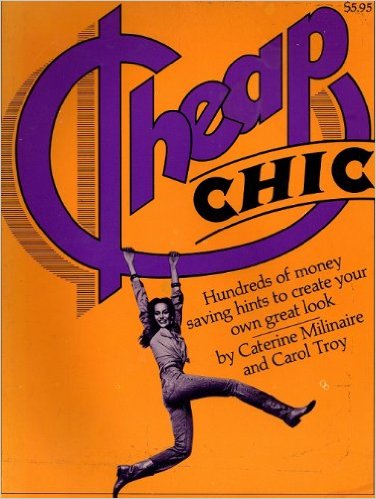Cheap Chic, the fashion classic, has been reprinted in a special 40th anniversary edition, with a foreword by Tim Gunn.
I don’t remember where I first read this book; it must have been in the 1980s, and I’m pretty sure it was a public library copy, the cover reinforced with whatever the library grade of Con-Tact paper is.
By that time I was already dressing much like the authors of the book, or as much like them as a high-school student in North Carolina could dress, so I read the entire thing as an exercise in confirmation bias. Of course I had olive drab army pants (several pair, including one I’d chopped off into shorts). I had multi-button wool sailors’ pants (too warm for the climate), men’s white t-shirts and oxfords, penny loafers, and (a significant find) a pair of incredibly beat-up (and uncomfortable) pair of boy’s cowboy boots, bought at a thrift store in Hickory, NC. I’d swiped my dad’s Levi’s jean jacket AND his Eisenhower jacket. I had good leather bags and belts (bought as seconds at the Coach outlet in town). I was certainly cheap; this book told me I was chic.
Re-reading Cheap Chic is half nostalgia, half discomfort. It’s difficult to read this now without noticing what I didn’t notice back in the eighties: the constant underscoring of the idea that the base requirement for chic is a “lean body” (and the assumption that everyone reading the book could easily fit into boy’s-size clothing and would be comfortable going braless in leotards). The regular and slightly thoughtless appropriation of clothing from different cultures and classes (“ethnic” and “worker’s” clothing), including the advice that you should “Tune into Soul Train when you’re running low on ideas!” And of course, so much fur!
The best reason to re-read Cheap Chic is for the interviews with designers, including Betsey Johnson, Rudi Gernreich, and (best of all) Diana Vreeland:

It’s hard to read Cheap Chic without thinking about the assumptions behind what made things cheap or chic: things were cheap because they were either made cheaply (by people you didn’t think much about otherwise), were the surplus of the militarization of the twentieth century, or because you had the resources to invest up-front in something well-made and expensive that would last a long time (Saint Laurent boots are mentioned often). Things were chic because they made you look young, cosmopolitan, well-traveled, thin, and rich.
I’d recommend reading Cheap Chic just to experience this discomfort, and to try to bring it forward into our lives now. What assumptions are we making today that will make our grandchildren cringe?

I will check out the book, the 70’s and 80’s were my rebel years and yes I can make my kids and grandkids cringe when the album comes out but I still have certain pieces that I can wear and get a wow comment every once in a while. Thanks for the article.
LikeLike
Isn’t it amazing and wonderful how times change? Back in the 70s and 80s, cultural appropriation was rarely questioned, and was considered chic. Today, it’s rare for a white person to be photographed in a feathered headdress (a stereotypical headdress, since each nation was different, with its own culture and traditions) without being criticized. But we still have a long way to go. With China as the theme for the Met Ball this year, there was an awful lot of cultural appropriation on the red carpet.
As an ethical vegan, I hope that in the future, we will cringe at fur, leather, feathers, wool, silk, and all fashion that exploits animals.
LikeLike
I hope our grandchildren will cringe at fast (and cheap) fashion, the idea of a new top every Friday and the use of polyester (made by oil).
LikeLike
I remember this book. I must have read it in high school or college. I seem to remember that one or both authors used to write for or be featured in New York magazine (I have in mind a photo of a woman striding down a City street in a huge, fur trapper’s hat in the middle of the summer.). That magazine was to me a herald of chic, more accessible than Vogue, but still completely unattainable. As an outer-borough person with Manhattan-born parents my goal was always to be a “real New York woman.”
In later years, the casual classism, racism and general clique quality of the magazine really turned me off.
LikeLike